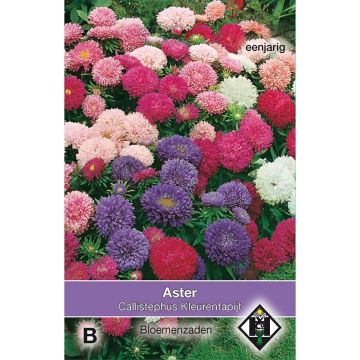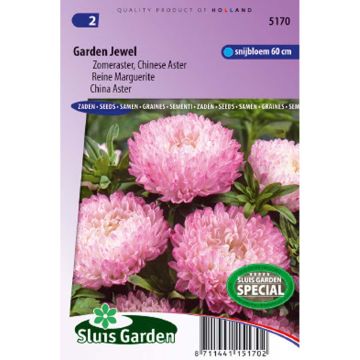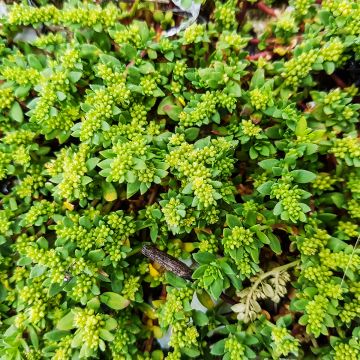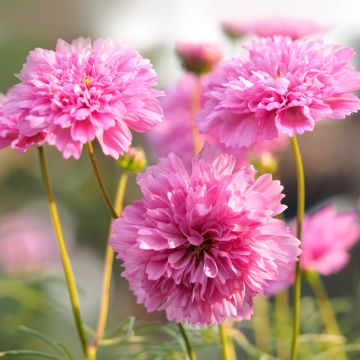

Callistephus chinensis Kleurentapijt
Callistephus chinensis Kleurentapijt
Callistephus chinensis Kleurentapijt
Chinese Aster
This item cannot be shipped to the selected country
Dispatch by letter from €3.90
More information
Schedule delivery date,
and select date in basket
This plant carries a 6 months recovery warranty
More information
We guarantee the quality of our plants for a full growing cycle, and will replace at our expense any plant that fails to recover under normal climatic and planting conditions.
Seed-only orders are dispatched by sealed envelope. The delivery charge for seed-only orders is €3.90.
Does this plant fit my garden?
Set up your Plantfit profile →
Description
The mix of Callistephus chinensis Kleurentapijt brings together several varieties of dwarf China Asters, producing double flowers in a range of shades from creamy white to deep red and violet blue. Their flowering lasts from July to October, depending on the sowing date. These plants are very low-growing and perfect for borders and flowering pots. Chinese asters can be sown under glass or directly in open ground, in a good, fertile, and well-drained soil. They are easy to grow, even for beginner gardeners.
Callistephus, also known as China Aster, is an annual plant from the Asteraceae family with a very ancient culture that has produced and still produces many very interesting varieties for flower beds and cut flowers. The plants in the Colour Carpet mix reach a height of 25 cm (10in) in a few months and are well-branched. Their stems bear oval and toothed leaves of bright green. The flowering is renewed for at least two months. Each flower, measuring 6 to 8 cm (2 to 3in) in width, is composed of multiple rows of colourful ligulate or petal-like florets surrounding a small centre of fertile florets in golden yellow, visible when the flower withers. The plant lives only one season, with time to flower and produce seeds.
Callistephus Colour Carpet is a flagship plant for borders and patios. It creates floral and colourful carpets that are truly decorative. Although a bit out of fashion, China asters remain popular plants for their abundant flowering and ease of cultivation. Their flowers are perfect in wildflower bouquets, and the plants bloom for months if you take care to remove the faded flowers. Even if only for bouquets, sow them in the vegetable garden to obtain a profusion of flowers at the end of summer. Among the wide range of varieties, you will find flowers of various shapes resembling chrysanthemums, with very fine, sometimes even tousled, finely tapered petals, in pompoms, or simple like those of the species. They come in many shades, ranging from white to yellow, and all shades of pink and purple. Dwarf cultivars will be perfect for borders and will thrive in balcony planters, while tall varieties with single or double flowers will decorate the back of flower beds.
Report an error about the product description
Flowering
Foliage
Plant habit
Botanical data
Callistephus
chinensis
Kleurentapijt
Asteraceae
Chinese Aster
Cultivar or hybrid
Other China Aster seeds
Planting and care
Sowing of Callistephus Kleurentapjit:
These plants should never be sown in the same place two years in a row. Sow outdoors from April to May, and transplant as soon as the plants have 2 to 4 leaves, at a spacing of 40 cm (16in), in a well-prepared, moist, and well-fertilised soil, in a sunny location. Water frequently, but sparingly. It is beneficial to transplant multiple times, keeping the root ball intact, to promote root development and limit the growth of the stems, which could break under the weight of the flowers. For earlier flowering, sow in pots or trays under glass, from February to April. Sow Callistephus in trays filled with sand and peat under cover, at a temperature of 16°C (60.8°F) to 20°C (68°F). Transplant into individual small pots when the seedlings have at least four leaves. Plant them in the garden when they reach a height of 15 cm (6in). Use stakes to support the taller varieties with double flowers. A later sowing in June allows for staggered blooming until the end of autumn. In this case, the seeds can be sown directly in the garden.
Cultivation:
These plants thrive in neutral to slightly alkaline, fertile, and well-drained soil, and require a sunny position. Adequate watering, twice a week during dry periods, is necessary, but be careful to water the base of the plant and not the foliage, as Callistephus are susceptible to powdery mildew. Remove old flowers regularly to prolong blooming and prevent weakening of the plant.
Sowing period
Intended location
This item has not been reviewed yet - be the first to leave a review about it.
Flower seeds
Haven't found what you were looking for?
Hardiness is the lowest winter temperature a plant can endure without suffering serious damage or even dying. However, hardiness is affected by location (a sheltered area, such as a patio), protection (winter cover) and soil type (hardiness is improved by well-drained soil).

Photo Sharing Terms & Conditions
In order to encourage gardeners to interact and share their experiences, Promesse de fleurs offers various media enabling content to be uploaded onto its Site - in particular via the ‘Photo sharing’ module.
The User agrees to refrain from:
- Posting any content that is illegal, prejudicial, insulting, racist, inciteful to hatred, revisionist, contrary to public decency, that infringes on privacy or on the privacy rights of third parties, in particular the publicity rights of persons and goods, intellectual property rights, or the right to privacy.
- Submitting content on behalf of a third party;
- Impersonate the identity of a third party and/or publish any personal information about a third party;
In general, the User undertakes to refrain from any unethical behaviour.
All Content (in particular text, comments, files, images, photos, videos, creative works, etc.), which may be subject to property or intellectual property rights, image or other private rights, shall remain the property of the User, subject to the limited rights granted by the terms of the licence granted by Promesse de fleurs as stated below. Users are at liberty to publish or not to publish such Content on the Site, notably via the ‘Photo Sharing’ facility, and accept that this Content shall be made public and freely accessible, notably on the Internet.
Users further acknowledge, undertake to have ,and guarantee that they hold all necessary rights and permissions to publish such material on the Site, in particular with regard to the legislation in force pertaining to any privacy, property, intellectual property, image, or contractual rights, or rights of any other nature. By publishing such Content on the Site, Users acknowledge accepting full liability as publishers of the Content within the meaning of the law, and grant Promesse de fleurs, free of charge, an inclusive, worldwide licence for the said Content for the entire duration of its publication, including all reproduction, representation, up/downloading, displaying, performing, transmission, and storage rights.
Users also grant permission for their name to be linked to the Content and accept that this link may not always be made available.
By engaging in posting material, Users consent to their Content becoming automatically accessible on the Internet, in particular on other sites and/or blogs and/or web pages of the Promesse de fleurs site, including in particular social pages and the Promesse de fleurs catalogue.
Users may secure the removal of entrusted content free of charge by issuing a simple request via our contact form.
The flowering period indicated on our website applies to countries and regions located in USDA zone 8 (France, the United Kingdom, Ireland, the Netherlands, etc.)
It will vary according to where you live:
- In zones 9 to 10 (Italy, Spain, Greece, etc.), flowering will occur about 2 to 4 weeks earlier.
- In zones 6 to 7 (Germany, Poland, Slovenia, and lower mountainous regions), flowering will be delayed by 2 to 3 weeks.
- In zone 5 (Central Europe, Scandinavia), blooming will be delayed by 3 to 5 weeks.
In temperate climates, pruning of spring-flowering shrubs (forsythia, spireas, etc.) should be done just after flowering.
Pruning of summer-flowering shrubs (Indian Lilac, Perovskia, etc.) can be done in winter or spring.
In cold regions as well as with frost-sensitive plants, avoid pruning too early when severe frosts may still occur.
The planting period indicated on our website applies to countries and regions located in USDA zone 8 (France, United Kingdom, Ireland, Netherlands).
It will vary according to where you live:
- In Mediterranean zones (Marseille, Madrid, Milan, etc.), autumn and winter are the best planting periods.
- In continental zones (Strasbourg, Munich, Vienna, etc.), delay planting by 2 to 3 weeks in spring and bring it forward by 2 to 4 weeks in autumn.
- In mountainous regions (the Alps, Pyrenees, Carpathians, etc.), it is best to plant in late spring (May-June) or late summer (August-September).
The harvesting period indicated on our website applies to countries and regions in USDA zone 8 (France, England, Ireland, the Netherlands).
In colder areas (Scandinavia, Poland, Austria...) fruit and vegetable harvests are likely to be delayed by 3-4 weeks.
In warmer areas (Italy, Spain, Greece, etc.), harvesting will probably take place earlier, depending on weather conditions.
The sowing periods indicated on our website apply to countries and regions within USDA Zone 8 (France, UK, Ireland, Netherlands).
In colder areas (Scandinavia, Poland, Austria...), delay any outdoor sowing by 3-4 weeks, or sow under glass.
In warmer climes (Italy, Spain, Greece, etc.), bring outdoor sowing forward by a few weeks.
























































